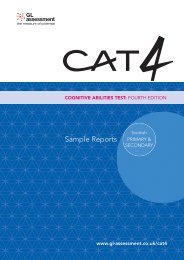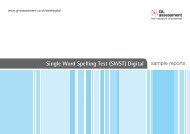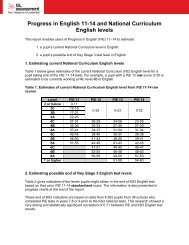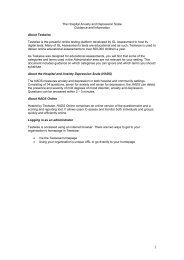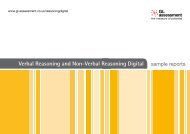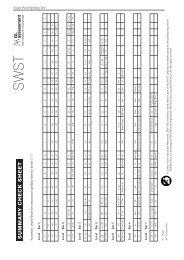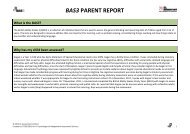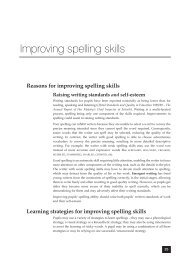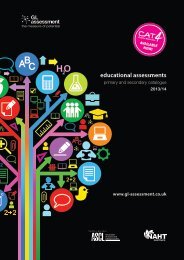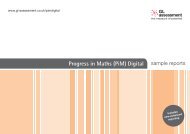DIAGNOSTIC TEST OF WORD READING PROCESSES
diagnostic test of word reading processes - GL Assessment
diagnostic test of word reading processes - GL Assessment
- No tags were found...
Create successful ePaper yourself
Turn your PDF publications into a flip-book with our unique Google optimized e-Paper software.
<strong>DIAGNOSTIC</strong><br />
<strong>TEST</strong> <strong>OF</strong><br />
<strong>WORD</strong><br />
<strong>READING</strong><br />
<strong>PROCESSES</strong><br />
Evaluation Teacher’s Guide Pack<br />
Forum for Research in Literacy and Language, Institute of Education
Diagnostic Test of Word Reading Processes<br />
Welcome to the Diagnostic Test of<br />
Word Reading Processes<br />
<strong>DIAGNOSTIC</strong><br />
<strong>TEST</strong> <strong>OF</strong><br />
<strong>WORD</strong><br />
<strong>READING</strong><br />
<strong>PROCESSES</strong><br />
Teacher’s Guide<br />
Forum for Research in Literacy and Language, Institute of Education<br />
Contents<br />
Introduction to the Diagnostic Test of Word Reading Processes 03<br />
Example reading cards 04<br />
An essential tutorial 06<br />
Examples 13<br />
Order form 16<br />
2
Evaluation Pack<br />
Introduction to the<br />
Diagnostic Test of Word Reading<br />
Processes<br />
The Diagnostic Test of Word Reading Processes is a test of word and non-word reading for children<br />
aged 6 to 12.<br />
The test comprises 90 items divided as follows:<br />
• 30 exception words which provide a measure of lexical-semantic processes;<br />
• 30 non-words which provide a measure of phonological recoding processes;<br />
• 30 regular words which can be read by either process.<br />
It is the first test to:<br />
• match words in the regular word and non-word sets by compiling non-words from segments of<br />
regular words;<br />
• match the regular and exception word sets according to their frequency of occurrence in books<br />
read by school children in the UK;<br />
• provide normative data obtained from a large and representative sample of children from<br />
Reception/P1 to Y7/S1 in schools in England.<br />
Quick and easy to administer, score and interpret, the Diagnostic Test of Word Reading Processes<br />
makes available to teachers a diagnostic tool that has long been used in research studies, and that<br />
enables precise specification of the areas of difficulty experienced by individual children in developing<br />
fluent and automatic word reading.<br />
Developed by the Forum for Research in Literacy and Language and used as a research tool over<br />
several years, the Diagnostic Test of Word Reading Processes standardisation was carried out in<br />
2009 and 2011 and the test yields an overall standard age score, age equivalent scores and an<br />
individual stanine score for each of its three component parts.<br />
3
Diagnostic Test of Word Reading Processes<br />
Sample non-words<br />
Example<br />
reading<br />
cards<br />
Practice items<br />
vip tek<br />
yol hap cug vus rit<br />
kem jid wex bof naz<br />
Please note: These are not actual words from the test, but are close approximations to the test content.<br />
NW1<br />
4
Evaluation Pack<br />
NW2<br />
Sample non-words II<br />
froll mong merfar hister nostchen<br />
hunril pringy kitcess bungentine turpalow<br />
Sample exception words<br />
do bear what people wolf<br />
eye country wealth rheumatism beautiful<br />
Sample regular words<br />
frog hill monster farmer kitchen<br />
nostril hungry princess bungalow turpentine<br />
Please note: These are not actual words from the test, but are close approximations to the test content.<br />
5
Diagnostic Test of Word Reading Processes<br />
An essential tutorial<br />
Introduction to the Diagnostic Test of Word Reading Processes<br />
What is involved in learning to read?<br />
There are two essential dimensions to learning to read: children must learn to recognise<br />
and understand written words, and they must learn to recover and interpret the literal and<br />
inferential meanings of texts. These two dimensions are encapsulated in the Simple View<br />
of Reading (Hoover and Gough, 1990). 3<br />
Figure 1.1: The Simple View of Reading<br />
Language<br />
Comprehension<br />
Processes<br />
Good<br />
Word<br />
Word<br />
Recognition<br />
Poor<br />
Good<br />
Recognition<br />
Processes<br />
Processes<br />
Poor<br />
Language<br />
Comprehension<br />
Processes<br />
Each dimension within this simple framework is far from ‘simple’, and involves the<br />
development and use of complex cognitive processes – processes operating within the<br />
mind and brain.<br />
6<br />
3<br />
Useful sources of information about the Simple View of Reading include: Adlof et al. (2006); Hoover and Gough (1990); Kendeou et al.<br />
(2009); Kirby and Savage (2008); Stuart et al. (2008).
Evaluation Pack<br />
What does the Diagnostic Test of Word Reading Processes assess?<br />
The test focuses on the cognitive processes that underlie the recognition and<br />
understanding of written words: the ‘word recognition’ dimension of the Simple View<br />
of Reading.<br />
It does this by assessing pupils’ performance on three types of word:<br />
• Regular words, for example ‘meet’, ‘shampoo’, ‘catapult’, which conform to the<br />
grapheme-phoneme correspondence (GPC) rules of the language<br />
• Exception words, for example, ‘was’, ‘yacht’, ‘meringue’, which do not conform to<br />
these GPC rules<br />
• Non-words, for example ‘brafe’, ‘meckton’, ‘shelibowt’, which are pronounceable<br />
sequences of letters that do not exist as real words in the language.<br />
What are these word reading processes?<br />
Over the past 50 years, there has been a huge amount of research devoted to<br />
understanding how people are able to recognise the individual sequences of letters that<br />
constitute each written word, and thereby gain access to the meaning and pronunciation<br />
of each word. Some areas of difference in detail remain between different theories.<br />
However, there is now a large measure of agreement that skilled readers have developed<br />
two interacting sets of processes that operate together on each written word. Therefore,<br />
pupils learning to read need to develop both sets of processes if they are to become<br />
skilled readers.<br />
In order to remain impartial with respect to the remaining differences between competing<br />
theories, the Diagnostic Test of Word Reading Processes uses the neutral terms ‘lexicalsemantic”<br />
and ‘phonological’ to describe these two sets of interacting processes. To make<br />
best use of the test, you need to understand what each set of processes involves. A brief<br />
account is provided below.<br />
What are lexical-semantic processes?<br />
Lexical-semantic processes depend upon accessing previously stored knowledge about<br />
words.<br />
Long before they start to learn to read, children have already stored the meanings and<br />
pronunciations of thousands of words that they use in their daily lives. Where a word is<br />
already stored in a pupil’s oral vocabulary, developing lexical-semantic processes involves:<br />
• storing knowledge of the letter sequence of the written form of the word<br />
• linking the letter sequence to its meaning.<br />
Word meanings already stored in oral vocabulary are already linked to their pronunciation.<br />
This means that accessing the meaning of the word automatically triggers access to its<br />
pronunciation.<br />
7
Diagnostic Test of Word Reading Processes<br />
However, reading soon becomes a major source of oral vocabulary development, and so<br />
pupils start to come across written words whose meanings and pronunciations are not<br />
already in their oral vocabulary. In these cases, developing lexical-semantic processes<br />
involves:<br />
• storing knowledge of the letter sequence of the written word<br />
• inferring something of the word’s meaning from the context in which it occurs<br />
• working out a pronunciation for the word from its letter sequence<br />
• linking the letter sequence to the word’s meaning and pronunciation.<br />
And, of course, unfamiliar words encountered in print may well be mispronounced: for<br />
example, ‘misled’ may become ‘mizzled’, and give rise to a new verb ‘to mizzle’ (as<br />
evidenced in the speech error ‘don’t mizzle me’).<br />
Once the letter sequence of a previously unknown written word has been stored and<br />
linked to its meaning and pronunciation, on subsequent encounters that written word<br />
will be recognised immediately on sight. Instant recognition leads to automatic and<br />
effortless recovery of the stored meaning and pronunciation. Lexical-semantic processing<br />
is extraordinarily fast and operates without any conscious awareness on the part of the<br />
skilled reader.<br />
Lexical-semantic processes are involved in reading all words, both regular and exception. 4<br />
However, they are uniquely tapped by Exception Word Reading, as Exception Word<br />
Reading is only achieved through lexical-semantic processing. Therefore, Exception Word<br />
Reading is used in this test as the measure of lexical-semantic processes.<br />
Importantly, the sequence of operations in lexical-semantic processing is from stored letter<br />
sequence to word meaning to word pronunciation. Thus, these processes allow us to<br />
distinguish between homophones like ‘sail’ and ‘sale’, even when we read them without<br />
any disambiguating context. The letter sequence ‘sail’ is linked to the meaning ‘an area of<br />
fabric used to catch the wind and propel a boat over water’, whereas the letter sequence<br />
‘sale’ is linked to the meaning ‘the exchange of goods, property or services for an agreed<br />
sum of money or credit’.<br />
8<br />
4<br />
The only requirement is that words should be familiar to the reader. That is, they must have been previously encountered in print<br />
sufficiently often for their letter sequences, meanings and pronunciations to have been stored. In skilled readers, one or two encounters<br />
with a written word are sufficient. For beginner readers, many more encounters are needed: some young beginner readers fail to<br />
recognise and understand written words that they have seen very many times previously (see, for example, Stuart et al., 2000).
Evaluation Pack<br />
Figure 1.2: Sequence of operations in lexical-semantic processing<br />
Written<br />
word<br />
SAIL<br />
Access stored<br />
letter sequence<br />
Access stored<br />
word meaning<br />
S-A-I-L<br />
‘an area of fabric<br />
used to catch the<br />
wind and propel<br />
a boat over<br />
water’<br />
Access stored<br />
word<br />
pronunciation<br />
/seɪl/<br />
S-A-L-E<br />
‘the exchange of<br />
goods, property<br />
or services for an<br />
agreed sum of<br />
money or credit’<br />
Access stored<br />
word<br />
pronunciation<br />
SALE<br />
Written<br />
word<br />
Access stored<br />
letter sequence<br />
Access stored<br />
word meaning<br />
What are phonological processes in reading?<br />
Phonological processes depend on the use of previously stored knowledge about<br />
correspondences between printed letters and letter groups (graphemes) and speech<br />
sounds (phonemes): that is, stored knowledge of grapheme-phoneme correspondence<br />
(GPC) rules. They are involved in reading regular words, whether or not these have been<br />
previously seen and stored, and non-words. Using phonological processes to read<br />
exception words would lead to a mispronunciation, for example reading ‘yacht’ to rhyme<br />
with ‘matched’. Phonological processes are uniquely tapped by Non-word Reading,<br />
because non-words do not exist as words in the language. They have not been seen<br />
before, and so their letter sequence cannot have been stored. They can only be read<br />
accurately by phonological processing. Therefore, Non-word Reading is used in the<br />
Diagnostic Test of Word Reading Processes as the measure of phonological processing.<br />
Development of phonological processes for word reading involves:<br />
• developing an understanding of the alphabetic principle, that phonemes in spoken<br />
words are represented by graphemes in written words<br />
• developing explicit awareness of the sequence of phonemes that constitute each<br />
spoken word<br />
• learning the correspondences between graphemes and phonemes<br />
9
Diagnostic Test of Word Reading Processes<br />
• learning to recognise graphemes in written words<br />
• learning to blend phonemes into whole-word pronunciations.<br />
Importantly, the sequence of operations in phonological processing is from letter<br />
sequences to grapheme-phoneme translation and phoneme blending, to word<br />
pronunciation and thence to word meaning.<br />
Figure 1.3: Sequence of operations in phonological processing<br />
Written<br />
word<br />
Identify<br />
graphemes<br />
SHAMPOO<br />
sh-a-m-p-oo<br />
Translate<br />
graphemes to<br />
phonemes<br />
sh ➔ /ʃ/<br />
a ➔ /a/<br />
m ➔ /m/<br />
p ➔ /p/<br />
oo ➔ /u/<br />
/ʃ-a-m-p-u/<br />
/ʃampu/<br />
Blend phonemes<br />
Access stored<br />
word<br />
pronunciation<br />
/ʃampu/<br />
Access stored<br />
word meaning<br />
‘soap to wash<br />
the hair’<br />
Developing and learning the necessary components for phonological processes to<br />
operate fluently can be a difficult task for some pupils. But phonological processes offer<br />
rich rewards for the reader. Learning a relatively small 5 set of GPC rules allows the pupil<br />
to work out pronunciations for the increasing numbers of unfamiliar written words they<br />
encounter. The meanings of many of these words may already be stored in the pupil’s oral<br />
vocabulary. Thus, working out the pronunciation allows the pupil to access the meaning<br />
of the word. As with lexical-semantic processes, something of the word’s meaning can be<br />
inferred from the context in which it is encountered, and stored for future use.<br />
In skilled readers, phonological processes operate automatically and fluently, without the<br />
conscious awareness of the reader.<br />
10<br />
5<br />
See, for example, Vousden et al., 2010.
Evaluation Pack<br />
How does the test assess lexical-semantic processes?<br />
The test contains sets of matched regular words and exception words. Pupils whose<br />
reading relies on the use of lexical-semantic processes will read regular and exception<br />
words to a broadly equivalent level, because both can be accurately pronounced by<br />
lexical-semantic processing. Pupils who also have well-developed phonological processes<br />
will tend to show an advantage for regular over exception words. This is because regular<br />
words can be pronounced accurately by both sets of processes, and so do not need to<br />
be already known and stored by the reader.<br />
As explained above, Exception Word Reading is the purest measure of lexical-semantic<br />
processes. Therefore, in the Diagnostic Test of Word Reading Processes, stanine scores 6<br />
for Exception Word Reading are used as the measure of lexical-semantic processes.<br />
How does the test assess phonological processes?<br />
The test also contains a set of non-words: letter sequences that could be words in the<br />
language, but that do not link to any meaning. The non-words in this test have been<br />
made by recombining letter sequences from the words in the regular word set: thus, all<br />
their component letter sequences are as familiar or unfamiliar to the pupil as the letter<br />
sequences in the regular words. Pupils whose reading relies predominantly on the use of<br />
phonological processes will read regular words and non-words to a broadly equivalent<br />
level, because both can be pronounced accurately by phonological processing. Their<br />
reading of exception words, which can only be pronounced accurately by lexical-semantic<br />
processes, will be relatively poorer.<br />
As explained above, Non-word Reading is the purest measure of phonological processes.<br />
Therefore, in the Diagnostic Test of Word Reading Processes, stanine scores for Non-word<br />
Reading are used as the measure of phonological processes.<br />
Why should I use the test?<br />
The Diagnostic Test of Word Reading Processes is the only standardised test with British<br />
English norms currently available that allows you to uncover the nature of the difficulties<br />
an individual pupil is experiencing in developing fluent automatic word reading processes.<br />
The pupil profile provided by administering this test can usefully inform your ability to<br />
provide teaching that is appropriate to the needs of the individual pupil, and that will help<br />
the pupil to overcome his or her difficulties.<br />
6<br />
See page 22 of the Teacher’s Guide for a definition of stanine scores.<br />
11
Diagnostic Test of Word Reading Processes<br />
When should I use the test?<br />
You can use the Diagnostic Test of Word Reading Processes to assess the word reading<br />
skills of all the pupils in your class, or you might prefer to use it selectively with pupils<br />
whose reading development is causing you concern.<br />
The Exception Word Reading/Non-word Reading comparisons reveal three different kinds<br />
of profile of reading difficulties:<br />
• a Lexical-Semantic profile, indicating relative difficulty in developing lexical-semantic<br />
processes<br />
• a Phonological profile, indicating a relative difficulty in developing phonological<br />
processes<br />
• a Mixed profile, indicating difficulty in developing both sets of processes.<br />
Procedures for obtaining and interpreting these profiles are described in Chapter 4.<br />
Suggestions for what to do once you have obtained and interpreted a profile for an<br />
individual pupil are given in Chapter 6.<br />
It is important to remember that the Diagnostic Test of Word Reading Processes is<br />
focused on the word reading dimension of the Simple View of Reading. It cannot<br />
(and is not intended to) identify pupils who are experiencing difficulties with reading<br />
comprehension, except in so far as those difficulties may be caused by poor or inefficient<br />
word reading skills. Pupils with age appropriate word reading skills who struggle to<br />
understand written texts appropriate to their age and interests should be given a prose<br />
reading test such as the York Assessment of Reading for Comprehension (YARC, Snowling<br />
et al., 2009).<br />
12
Evaluation Pack<br />
Examples using words supplied in the<br />
Evaluation Pack<br />
Example 1<br />
Exception Regular Non-word<br />
do<br />
√<br />
frog<br />
√<br />
froll<br />
√<br />
bear<br />
√<br />
hill<br />
√<br />
mong<br />
√<br />
what<br />
√<br />
monster x merfar x<br />
people<br />
√<br />
farmer<br />
√<br />
hister x<br />
wolf x kitchen<br />
√<br />
nostchen x<br />
eye<br />
√<br />
nostril x hunril x<br />
country x hungry<br />
√<br />
pringry x<br />
wealth x princess x kitcess x<br />
rheumatism x bungalow x bungentine x<br />
beautiful x turpentine x turpalow x<br />
Exception word<br />
Regular word<br />
Non-word<br />
= 5 correct<br />
= 5 correct<br />
= 2 correct<br />
From these raw scores it looks as though this child reads exception words and regular words equally<br />
well, and that he/she reads words better than non-words. However, raw scores are misleading and<br />
you cannot draw any conclusions from them. You need to convert raw scores to stanine scores using<br />
the normative data tables.<br />
Using stanine scores, the test is designed to reveal three patterns (‘profiles’) of word reading. This can<br />
be done by simply comparing the child’s stanine score for exception words with their stanine score for<br />
non-words.<br />
Let’s imagine that the child in the example above achieved a stanine score of 3 for exception word<br />
reading, and 1 for non-word reading.<br />
As you can see, these stanine scores give the child a<br />
phonological profile. The child relies mostly in reading on<br />
lexical-semantic processes, which can read all words, regular<br />
as well as exception, as long as they are already familiar<br />
to the child. Unfamiliar words cannot be decoded using<br />
phonological recoding processes. Intervention for this child<br />
should concentrate on developing his/her phonological<br />
recoding processes.<br />
13
Diagnostic Test of Word Reading Processes<br />
Example 2<br />
Exception Regular Non-word<br />
do<br />
√<br />
frog<br />
√<br />
froll<br />
√<br />
bear<br />
x<br />
hill<br />
√<br />
mong<br />
√<br />
what<br />
√<br />
monster<br />
√<br />
merfar<br />
√<br />
people<br />
√<br />
farmer<br />
√<br />
hister<br />
√<br />
wolf x kitchen<br />
√<br />
nostchen<br />
√<br />
eye x nostril<br />
√<br />
hunril<br />
√<br />
country x hungry x pringry x<br />
wealth x princess<br />
√<br />
kitcess x<br />
rheumatism x bungalow x bungentine x<br />
beautiful x turpentine x turpalow x<br />
Exception word<br />
Regular word<br />
Non-word<br />
= 3 correct<br />
= 7 correct<br />
= 6 correct<br />
From these raw scores it looks as though this child reads regular words and non-words equally well,<br />
but finds exception words difficult.<br />
However, raw scores are misleading and you cannot draw any conclusions from them.<br />
You need to convert raw scores to stanine scores using the normative data tables.<br />
Using stanine scores, the test is designed to reveal three patterns (‘profiles’) of word reading.<br />
This can be done by simply comparing the child’s stanine score for exception words with their stanine<br />
score for non-words.<br />
Let’s imagine that the child in the example above achieved a stanine score of 2 for exception word<br />
reading, and 5 for non-word reading.<br />
As you can see, these stanine scores give the child a<br />
lexical-semantic profile. He/she relies mostly in reading on<br />
phonological recoding processes, which can read nonwords<br />
and regular words, whether or not the latter are already<br />
familiar to the child. However, he/she has difficulty with<br />
exception words, as these can only be read accurately by<br />
lexical-semantic processes. Intervention for this child should<br />
concentrate on developing his/her lexical-semantic processes.<br />
14
Evaluation Pack<br />
Example 3<br />
Exception Regular Non-word<br />
do<br />
√<br />
frog<br />
√<br />
froll<br />
√<br />
bear x hill<br />
√<br />
mong<br />
√<br />
what<br />
√<br />
monster x merfar x<br />
people<br />
√<br />
farmer x hister x<br />
wolf x kitchen x nostchen x<br />
eye x nostril x hunril x<br />
country x hungry x pringry x<br />
wealth x princess x kitcess x<br />
rheumatism x bungalow x bungentine x<br />
beautiful x turpentine x turpalow x<br />
Exception word<br />
Regular word<br />
Non-word<br />
= 3 correct<br />
= 2 correct<br />
= 2 correct<br />
From these raw scores it looks as though this child has equal difficulty reading all three types of word.<br />
However, raw scores are misleading and you cannot draw any conclusions from them.<br />
You need to convert raw scores to stanine scores using the normative data tables.<br />
Using stanine scores, the test is designed to reveal three patterns (‘profiles’) of word reading.<br />
This can be done by simply comparing the child’s stanine score for exception words with their stanine<br />
score for non-words.<br />
Let’s imagine that the child in the example above achieved a stanine score of 2 for exception word<br />
reading, and 1 for non-word reading.<br />
As you can see, these stanine scores give the child a mixed<br />
profile. He/she has not developed either set of word reading<br />
processes to an age-appropriate level, and has no relative<br />
strength or weakness in one or other set. Intervention for this<br />
child should concentrate on developing both phonological<br />
recoding and lexical-semantic processes.<br />
15
Diagnostic Test of Word Reading Processes<br />
Using the Diagnostic<br />
Test of Word Reading<br />
Processes and<br />
Phonological<br />
Assessment Battery<br />
together<br />
Secure your copy of<br />
the brand new Diagnostic Test of<br />
Word Reading Processes<br />
4 easy ways to order<br />
1) Photocopy and fax this order form to 0845 601 5358<br />
2) Post it to: GL Assessment, FREEPOST LON16517, Swindon SN2 8BR<br />
3) Call 0845 602 1937<br />
4) Visit www.gl-assessment.co.uk and enter DTWRP or PhAB into the Search<br />
box (no credit card required – we invoice your school)<br />
+<br />
For advice on the Diagnostic Test of Word Reading Processes or any of our other<br />
assessments, or to arrange a visit from your local Area Consultant to discuss your<br />
reading assessment needs in more detail, please call 0845 602 1937 or send an email<br />
to info@gl-assessment.co.uk. Alternatively, find your local Area Consultant online at<br />
www.gl-assessment.co.uk/findyourrep.<br />
Mr/Mrs/Miss/Ms<br />
Job Title<br />
Address<br />
Post Code<br />
GL Assessment’s Phonological<br />
Assessment Battery (PhAB) is an<br />
ideal follow-on assessment for<br />
some children tested with the<br />
Diagnostic Test of Word Reading<br />
Processes. The latter is designed<br />
to benchmark and test pupils’<br />
developing skills in word reading<br />
and can be used to track progress<br />
as part of a school’s assessment<br />
regime. If persistent problems are<br />
detected then the specialist<br />
teacher/SENCO could administer<br />
PhAB, a well-established test that<br />
looks at six different areas of<br />
phonological processing.<br />
Tel<br />
Email<br />
Official Order No.<br />
Paying Authority/School<br />
Please invoice me Cheque enclosed Amount: £ ___________<br />
(payable to GL Assessment)<br />
Title Code Price Qty Total<br />
Diagnostic Test of Word Reading Processes<br />
Complete Set 978 07087 20721/GLA449 £100.00*<br />
Record Forms (Pack of 50) 978 07087 20738/GLA449 £35.00*<br />
Phonological Assessment Battery (PhAB)<br />
Complete Set 978 07087 07081/GLA449 £119.99*<br />
Record Forms (Pack of 10) 978 07087 07098/GLA449 £17.99*<br />
Fax<br />
Please contact us for more<br />
information:<br />
T: 0845 602 1937<br />
E: info@gl-assessment.co.uk<br />
*+VAT<br />
**UK postage and packing: Add £4.15 if enclosing payment<br />
with your order (If you are not enclosing payment, you will be<br />
charged the full cost of postage based on weight and<br />
delivery date required.)<br />
Sub Total<br />
P&P**<br />
+VAT @ 20%<br />
TOTAL<br />
GLA475 GLA449




